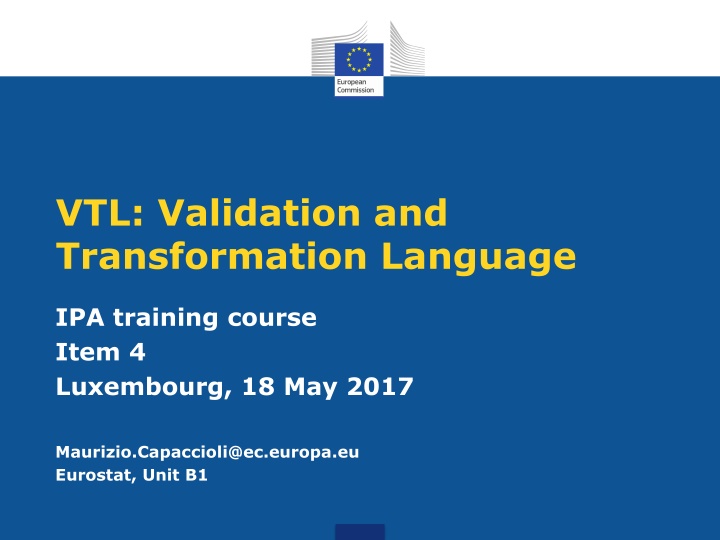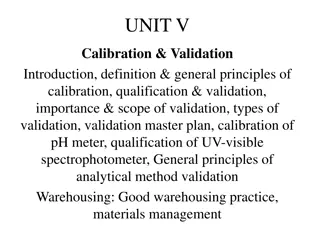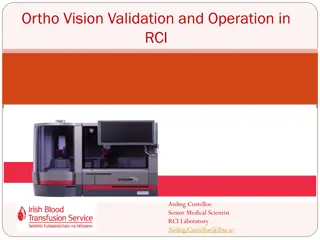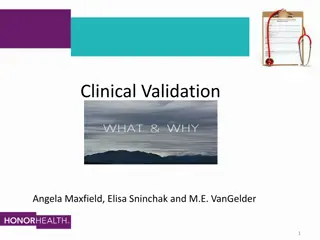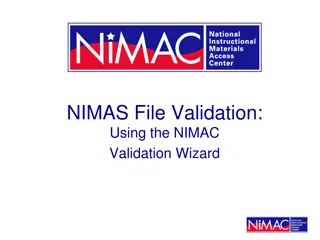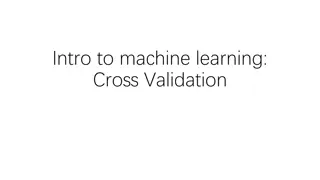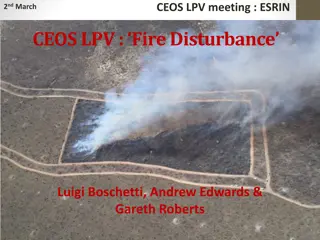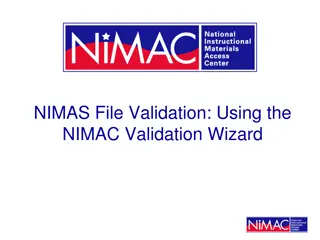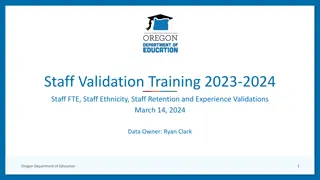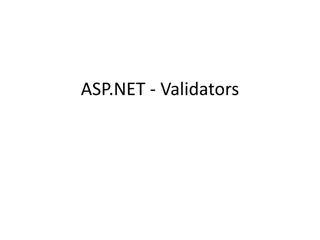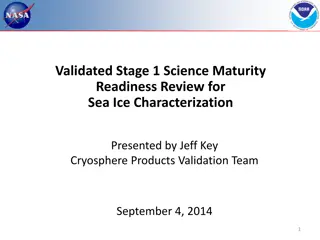VTL: Validation and Transformation Language Overview
The Validation and Transformation Language (VTL) is a powerful tool used by international organizations to standardize data exchange processes among member countries. VTL serves multiple purposes, such as facilitating communication of validation rules and implementing data transformations efficiently. This language operates on datasets defined by dimensions, measures, and attributes, enabling seamless data manipulation. Learn about VTL's main principles, key features, and how it enhances statistical data exchange.
Download Presentation

Please find below an Image/Link to download the presentation.
The content on the website is provided AS IS for your information and personal use only. It may not be sold, licensed, or shared on other websites without obtaining consent from the author.If you encounter any issues during the download, it is possible that the publisher has removed the file from their server.
You are allowed to download the files provided on this website for personal or commercial use, subject to the condition that they are used lawfully. All files are the property of their respective owners.
The content on the website is provided AS IS for your information and personal use only. It may not be sold, licensed, or shared on other websites without obtaining consent from the author.
E N D
Presentation Transcript
VTL: Validation and Transformation Language IPA training course Item 4 Luxembourg, 18 May 2017 Maurizio.Capaccioli@ec.europa.eu Eurostat, Unit B1
VTL: the origin Implementation of the SDMX information model package on "Transformations and Expressions" Based on a generic information model that can be used with different standards: SDMX, DDI, GSIM or others VTL is maintained by the VTL Task Force, composed of members of Eurostat, ECB, ILO, INEGI, Bank of Italy, ISTAT The VTL Task Force works under the umbrella of the SDMX Technical Working Group
SDMX, which stands for Statistical Data and Metadata eXchange is an international initiative that aims at standardising and modernising ( industrialising ) the mechanisms and processes for the exchange of statistical data and metadata among international organisations and their member countries. SDMX is sponsored by seven international organisations including the Bank for International Settlements (BIS), the European Central Bank (ECB), Eurostat (Statistical Office of the European Union), the International Monetary Fund (IMF), the Organisation for Economic Cooperation and Development (OECD), the United Nations Statistical Division (UNSD), and the World Bank.
VTL purposes 1. provide an unambiguous language to communicate validation rules between different statistical organisations 2. provide a high-level language to document the data transformations 3. provide an efficient language for implementing data validation services 4. provide an efficient language for implementing data transformations
Versions of VTL VTL 1.0 published in March 2015 Collection of comments (public review) VTL 1.1 published in November 2016 Collection of comments (public review) VTL 1.1 final release will be published in July 2017 SDMX web site: http://sdmx.org/?page_id=5096
VTL main principles Most of the VTL operators operate on datasets A dataset is described by dimensions, measures and attributes Example: ds_bop_1 REF_AREA EU25 BG RO EU27 PARTNER CA CA CA CA TIME 2010 2010 2010 2010 OBS_VALUE 20 1 1 23 OBS_STATUS D P P P Dimension Measure Attribute
VTL main principles Example of a typical VTL operation: ds3 := ds1 + ds2 Operations carried out by VTL: join the data points of the ds1 and ds2 using the dimension values apply the scalar function "+" to all pairs of numeric measures of ds1 and ds2 having the same name if desired, execute an attribute propagation function defined by the user (e.g. concatenate the "flag" attribute of the two data points) create a temporary dataset containing the resulting data points
Example of VTL validation rules Hierarchical validation rules Data point validation rules Time-series rules Boolean conditions check ( ds1#obs_value >= 0 )
VTL - hierarchical ruleset Example of VTL validation rules Hierarchical ruleset: hr_euro_agg N. Antecedent variables: Rule variables: time ref_area EU15 = AT + BE + LU + DE + ES + FI + FR + EL + IE + IT + NL + PT + DK + UK + SE 1 2 EU25 = EU15 + CY + CZ + ES + HU + LT + LV + MT + PL + SK + SI 3 EU27 = EU25 + BG + RO 4 EU28 = EU27 + HR 5 time between 1995 and 2003 EU = EU15 6 time between 2004 and 2005 EU = EU25 7 time between 2006 and 2012 EU = EU27 8 time >= 2013 EU = EU28 9 EEA15 = EU15 + IS + NO + LI 10 EEA25 = EU25 + IS + NO + LI 11 EEA27 = EU27 + IS + NO + LI 12 EEA30 = EU27 + IS + NO + LI 13 time between 1995 and 2003 EEA = EEA15 14 time between 2004 and 2005 EEA = EEA25 15 time between 2006 and 2012 EEA = EEA27 16 time >= 2013 EEA = EEA30
VTL datapoint validation ruleset create datapoint ruleset dr_flow_positive ( flow, obs_value ) when flow = "IMP" or flow = "EXP" then obs_value > 0 ; end horizontal ruleset The datapoint ruleset: is defined on the variables flow and obs_value verifies that in each data point of the dataset to be validated (not shown here) the component obs_value is greater than zero when the flow is "IMP" or "EXP". the above syntax creates a ruleset (a permanent object) named "dr_flow_positive" 10 ESTAT
VTL checking boolean conditions ds_result := check ( ds1 # obs_value > 1000, errorcode ( "Value must be greater than 1000" ) ) 11 ESTAT
Exercise 1 VTL code: ds_result := check ( ds_bop # time_period between 2008 and 2015, errorcode( _____ ), errorlevel( Error ) ) ; ds_bop is the dataset containing the data to be validated Question: What is the correct text (error message) to be inserted in _____ ? 12 ESTAT
Exercise 2 ds_bop1 REF_AREA EU25 BG RO EU27 PARTNER CA CA CA CA TIME 2010 2010 2010 2010 OBS_VALUE 20 1 1 23 OBS_STATUS D P P P VTL code: result := check ( ds_bop1 # obs_value, hr_euro_agg ) ; hr_euro_agg is the hierarchical ruleset described in slide 9. Question: What is that data point contained in the ds_result dataset? 13 ESTAT
Exercise 3 ds_bop1 REF_AREA EU25 BG RO EU27 PARTNER CA CA CA CA FLOW IMP IMP IMP IMP TIME 2010 2010 2010 2010 OBS_VALUE 20 1 0 23 OBS_STATUS D P P P VTL code: ds_result := check ( ds_bop1, dr_flow_positive ) ; dr_flow_positive is the datapoint ruleset described in slide 10. Question: What is that data point contained in the ds_result dataset? 14 ESTAT
VTL assessement of usability Assessment of usability by statisticians: Covering several domains: Animal Production, Asylum, International Trade in Services, Energy, National Accounts, Short Term Statistics Participation of 8 countries + Eurostat Some comments received: Rules in plain english and examples of bad/good data are both essential Rules in VTL may be useful as complement (to limit risks of ambiguity) Need to agree on way to express the rule (negative or positive) 15 ESTAT
Development of VTL tools IT tools and services under development: ECB Norway VTL parser Java API based on JSON-stat format https://github.com/statisticsnorway/java-vtl VTL to SQL translator UNECE paper Poland Istat ESTAT ESTAT ESTAT VTL Editor Compiler (part of the Validation Service) Validation Rule Manager Sandbox: simple GUI + VTL translator to SQL 16 ESTAT
Use of VTL Use of VTL: ECB BIRD portal VTL is used to document the data validations and transformations of the statistical process: http://banks-integrated-reporting-dictionary.eu/bird-group Continuous Capture of Metadata VTL is used as a common language to describe data transformations http://c2metadata.org/ 17 ESTAT
Thank you for your attention! Any questions?
